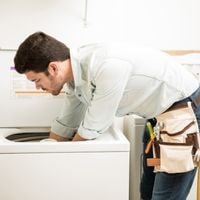Whirlpool dryer overheating. If your Whirlpool clothes dryer experiences overheating, you may want to address the problem by figuring out what the most likely causes are.
Although it has a heat-sensitive safety device that can control power usage and prevent fires from starting, overheating is still something that can put stress on your dryer. Fortunately, there are a few different reasons why your dryer may be overheating.
Whirlpool dryer overheating
There are many reasons why your dryer might overheat, from a previous repair to simply being overloaded with too many clothes. To pinpoint the problem before continuing to use the dryer.
You’ll need to troubleshoot before just jumping into any repairs. Resolve the issue before returning that hot appliance back into service.
Blockage of the exhaust system
An unclean exhaust system can significantly damage a Whirlpool clothes dryer. When the ventilation apparatus becomes clogged with lint or debris.
It becomes difficult for hot air to leave the drum for an extended time period and as a result, excessive heat is generated. Follow the manufacturer’s guide to clean your dryer’s exhaust system.
Shorted heating element
Inside the heating element, there is an open filament and a closed filament. The closed filament is grounded while the open one is not grounded. If these are switched, it will cause a short circuit.
This can make the heating element heat up too much and eventually melt. To determine if your heating element is shorted out, you’ll need a multimeter to test each terminal for continuity to its case (metal part of the housing).
If both filaments have continuity, then your heating element needs replacement.
The cycling thermostat is broken
Inside your Whirlpool dryer’s barrel is a thermostat. It monitors the temperature and turns the heating element up or down so that it can keep it at a constant level as you’re drying your clothes.
But what if it breaks? Well, it won’t be able to regulate properly and might fire off instructions that heat the heating element too much, frying the parts instead of drying your clothes.
Keep an eye on the thermostat for any signs of damage and replace it immediately if you think something went wrong.
Air Flow Issues
If the venting system is clogged, it will restrict the airflow through your dryer. This can increase drying time, and overtime costs you money by increasing energy bills and potentially causing repair bills.
If a lint catcher is used, or there is an exhaust hose near the ground, make sure they are cleaned regularly too.
Replace the Blower Wheel
The blower wheel works with the drum to draw air into it and dispel it out of the dryer. Clumps of lint, socks and small articles of clothing can get stuck in the blower wheel cage, making it harder for the motor to drive.
In addition, the rotating component that holds the blower wheel together can fray or wear out over time. If the centrifugal force is too much for this component then one may end up with an improperly spinning blower wheel which compromises airflow.
The best way to diagnose this situation is by removing one’s venting hose assembly and seeing if there is a substantial amount of airflow coming from the said hose.
If there isn’t enough airflow then one may need to check their blower wheel for clogs or obstructions as well as replace any faulty parts (blower wheel assembly).
Defective Felt Seal
Most dryers have a felt seal around the exterior of the drum to prevent heat from escaping the drum. If this seal is worn out or missing, the dryer will overheat and potentially damage your clothing.
To check if your seal is defective, remove it and inspect it for holes or tears – if it passes inspection then you know you need to replace it.
Of course, there are some cases where a machine just burns everything, and no matter what you do, even after replacing all of the parts with new replacements.
It still can’t seem to function properly so make sure you’ve checked everything else first before moving forward with repairs even after inspecting the felt seal.
Related Guides
